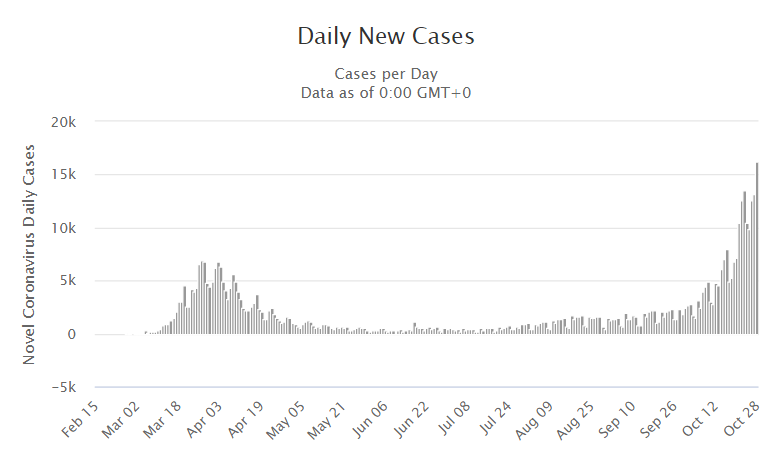German, Eurozone Economies Set for New Contraction, Damage to Grow if Restrictions Prolonged
- Written by: James Skinner
-

Image © Alfred Yaghobzadeh, European Commission Audiovisual Services.
Germany and Europe's economies are on course for a fresh contraction due to new coronavirus containment measures announced this week, according to Deutsche Bank and Morgan Stanley forecasts, although the anticipated damage could grow quickly if the new restrictions are either enhanced or prolonged.
Europe's largest economy and export powerhouse will enter a new but partial form of 'lockdown' on Tuesday, 02 November where "institutions and facilities classified as recreational" including restaurants, bars, clubs, theatres, concert halls, museums, cinemas, sports grounds, swimming pools, leisure parks and others must all close.
All affected businesses have been instructed to remain closed at least until the end of the month as part of authorities' latest attempt to contain the sometimes pneumonia-inducing coronavirus, which takes a meaningful part of Germany's economy offline for at least a part of the final quarter and risks snuffing out its recovery at least for a time.
"The big exception is that schools, day nurseries, the retail sector, hairdressers and medical therapists remain open," says Stefan Schneider, chief economist at Deutsche Bank. "Lockdown measures should result in a Q4 GDP decline of at least 0.5% qoq. In particular, hospitality and cultural institutions will suffer most."
Source: Worldometers.
Like in many other countries Germany's second wave has grown larger than its first in some respects, with new infections detected and declared each day having more-than doubled on those seen in the prior outbreak.
The effect has been to almost double the total German infection count in the space of a month, with 479,621 instances of infection known of on October 28, up from 288,618 on September 28. Daily deaths have increased from 11 to 96 in that time but remain below the peaks seen during the initial outbreak.
Chancellor Angela Merkel cited in a press conference on Wednesday, the speed at which the virus is spreading as an important driver of the decision to again force some businesses to close, which is a major curveball for a German economy that's yet to recover from the earlier more draconian shutdown.
“The current measures are likely to signal the seriousness of the health situation and thus also intensify the precautionary behaviour of households. What is more, rising infections rates in Europe and the US could dampen demand for German export goods," Schneider says. "With weaker economic momentum now expected in 2020 Q4, the carryover effect for 2021 will be significantly reduced. Moreover, it cannot be ruled out that we will experience another / extended lockdown in the first months of 2021."
Source: Worldometers.
Germany’s economy already contracted by -9.7% in the second-quarter and is forecast by Deutsche Bank to shrink -5.6% for 2020 overall, although this latter expectation is hinged on the assumption that Deutsche's forecast for a third-quarter rebound of +6% is too low.
It could be too low, given that consensus expects Germany to rebound +7.3% when last quarter's numbers are announced at 07:00 on Friday, but this and the anticipated -0.5% decline for the current quarter assume that new restrictions won't be enhanced or prolonged beyond month-end. That's exactly what happened in the initial shutdown.
Back in March, business closures and confinements to homes were first intended to last for as little as two weeks in some states as well as other European countries, but were quickly extended in duration. If this happens again, the bill for the damage will grow larger.
“It looks like winter will see persistent restrictions across Europe. We project a 0.1%Q fall in euro area GDP over 4Q20 and a weak 1Q21, with downside risks if the restrictions persist or become more stringent. We expect further policy support,at the national fiscal level as announced today in France and Germany,and from the ECB, who we expect to ease again in December," says Jacob Nell, an economist at Morgan Stanley.
Source: Eurostat.
Meanwhile, restrictions have been tightened elsewhere in Europe too with President Emmanuel Macron also announcing on Wednesday that France will return to ‘lockdown’ for at least the November month. That means the Eurozone’s two largest economies have now joined its third and fourth largest, Spain and Italy, in taking themselves partially offline at a crucial point for the bloc’s economic recovery.
Eurozone GDP fell by a much larger -11.8% during the second quarter, although consensus expects that data due for release on Friday will reveal a rebound of around 9.4%. But with the bloc's four largest economies back in a partial form of 'lockdown' midway through the final quarter while smaller economies also tighten up restrictions on activity, a pending final quarter contraction also threatens the outlook for next year.
This week's shutdowns are a threat to Europe's perceived leadership position in the transatlantic growth race. Europe's economies including those in the UK are closing down again as Americans prepare to head to the polls on November 03 to vote in a landmark election, considerations of which may have kept state level governors and authorities from following suit in the U.S., despite it also seeing a sharp rise in new infections.
"Belgium looks to have the health care system under most strain,and further restrictions look likely to be announced on Friday," Nell says. "Further measures in Italy and the Netherlands also look possible. More hopefully, cases in Ireland, which imposed a similar partial lockdown a week ago, with non-essential retail and leisure/hospitality closed, seem to be edging lower."
Above: Second quarter GDP changes for Euro area, EU and U.S. Source: Eurostat.













